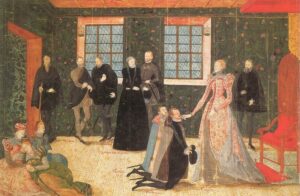
Today’s episode of BBC Radio 4’s Book of the Week, featuring “Elizabeth’s Women” by Tracy Borman, was mainly about Elizabeth’s household, the ladies who attended her. The programme also mentioned Elizabeth’s lavish coronation which was based on Anne Boleyn’s coronation which took place just over 25 years earlier – you can read about that over at The Anne Boleyn Files.
Here is a precis of today’s episode:-
Life at Court
After the major public relations exercise of her coronation, Elizabeth I turned her attention to her court. Tracy Borman writes of how crucial it was for Elizabeth’s court to be a “glorious, ostentatious display” to show the Queen’s wealth and majesty. Elizabeth’s court was known for being a “theatre” of music, dance and art, and the Queen was well known for her sumptuous banquets with tens of tasty dishes which always ended with some exquisite confectionery. On one occasion, Elizabeth even had a menagerie of animal and mythical beasts sculpted out of sugar!
Borman is quick to point out that although Elizabeth’s court came across as decadent, Elizabeth always kept tight control over proceedings, never allowing drunkenness or behaviour of an overly sexual nature, after all, she was an unmarried queen who wanted to be seen as the Virgin Mary on Earth, and she needed an unblemished reputation.
Elizabeth’s Ladies
As princess, Elizabeth had already had her own household of trusted ladies and attendants whom she took with her as Queen. Her former governess Kat Ashley was appointed Chief Gentlewoman of the Privy Chamber, the most prestigious post in the Queen’s household, and her good friend Blanche Parry became the Second Gentlewoman of the Privy Chamber. Both of these women had served Elizabeth for over twenty years and she knew she could trust their loyalty and valued them as friends.
It is also telling that many of the other women in Elizabeth I’s household were either women who had served her late stepmother, Catherine Parr, or were Boleyn relatives – Howard, Carey and Knollys women.
The Ladies’ Duties
Tracy Borman writes of how Elizabeth’s ladies were indispensable, not only for the chores that they did but also because they provided a “backdrop” for the Queen’s beauty. As we all know, Elizabeth loved to wear extravagant, colourful costumes covered in jewels and accessorised with more jewels and her bright red wigs, yet she dressed her ladies in humble black and white so that she could outshine them.
The structure of Elizabeth’s household was carefully organised and controlled by the Queen, and consisted of a series of “chambers” that courtiers could progress through:-
- The Presence Chamber – Courtiers flocked to the presence chamber in the hope of getting an audience with the Queen. Ladies of the Presence Chamber were only required to attend when the Queen called for them and when she was granting special audiences to foreign ambassadors and other important people.
- The Privy Chamber – This was the Queen’s “day room” and only the most important courtiers managed to gain entrance to this chamber.
- The Queen’s Bedchamber – This was Elizabeth’s private “refuge”, where only a small number of very trusted ladies served her. Borman writes of how it was incredibly rare for any man to gain entry to this chamber and it was the ladies of the bedchamber who saw the real Elizabeth, the true face of the Queen and the Queen at her most vulnerable.

Helping the Queen get ready was no easy job. Unlike most people of her time, Elizabeth loved cleanliness and bathed or washed regularly. Her ladies would have helped her bathe in her special tub, they would have washed her and also cleaned her teeth with a special concoction made out of white wine, vinegar and honey, which was applied to her teeth with cloths. Dressing the Queen generally took at least one hour because of the many layers of clothes which each had to be fastened with laces or evens, and even sewn on! All of this had to be done before Elizabeth would even think of being seen by others, especially the men of the court.
Sacrifice, Hardship and Power
Although “guaranteed access to the monarch was guaranteed power” and there was very fierce competition to serve the Queen, life for a Queen’s lady was one of sacrifice and incredibly hard work. Tracy Borman points out that it was a far easier life to live in your own home, rather than be at court and attend on the Queen.
Elizabeth was a hard taskmaster (or mistress!), with very high standards. She expected all of her ladies to put her first and to be available to her at all hours. Even illness, marriage or problems at home were no excuse for missing a day of work and if a lady became pregnant, Elizabeth would expect them back at work as soon as possible after the birth and the ladies were forced to leave their baby with a wet nurse and put the Queen first. It sounds harsh by our 21st century standards but it was entirely normal in those days, a monarch was God’s appointed ruler and always came first.
Elizabeth needed to be attended at all time and even had a lady sleep in her room. Again, this was normal. Not only did it protect the Virgin Queen’s reputation, but it was also for her security. Elizabeth’s life was constantly under threat and this worsened after the Pope excommunicated her in 1570 and encouraged Catholics to rise against her. After this, Elizabeth’s ladies had to taste her food before she consumed it, search her bedchamber before she retired for the night and test perfumes and gifts. Their lives were obviously not as important as the Queen’s.
Even though these ladies worked exceedingly hard, their pay was low or even non-existent. Even Ladies of the Privy Chamber and Bedchamber only received the equivalent of around £5,500 per annum. Although they did get food, accommodation, light and fuel, their food consisted of leftovers from the Queen’s table which Borman says usually had to be shared between around 20 women! Their accommodation was also severely lacking and they had no privacy at all. They often had to do without fireplaces, bathrooms and proper toilets, and it is no wonder that Elizabeth’s court had to move round so much – the stench got unbearable and palaces had to be cleaned.
Borman mentioned in her interview with BBC History Magazine that Elizabeth was very jealous and bitter in later life and that she would rant at her ladies and even beat them. In today’s episode, she writes of how Elizabeth expected perfection and that she would slap or beat her ladies if they did something wrong, and that she even stabbed a lady in the hand when she was clumsy serving the Queen’s dinner! I know that Elizabeth was quick-tempered, like her parents, but I’d like to know where this story comes from because in my opinion it shows a lack of control and I believe that Elizabeth had more control of her actions and feelings than this – I could be wrong!
A perk for the higher ladies, as well as hearing the Queen’s innermost thoughts and feelings, was that they were often rewarded with gifts of clothes or jewellery from Elizabeth herself or from courtiers who wished to “bribe” them to gain access to the Queen or to win favour. I’m sure that these gifts did not entirely make up for being “on call” 24 hours a day, living in appalling conditions and being moaned at!
You can listen to the Radio programme yourself at the BBC Radio 4 Book of the Week website – it will be available for the next few days. You can also catch up on episodes 1 and 2.
“Elizabeth’s Women: The Hidden Story of the Virgin Queen” by Tracy Borman is available at Amazon UK which does ship internationally.









We shouldn’t forget how much Robert Dudley, later Earl of Leicester, had to do with orchestrating the events that allowed Elizabeth to become the icon she was and still is. He was master of horse, which meant that he had responsibility for all her entertainments. He planned them with an eye to presenting Elizabeth at her best, regal and godess-like. She owed to him a great deal of her fame and popularity and she knew it.
Jeane Westin, author of The Virgin’s Daughters, NAL, August, 2009
Very true, Jeane, he was very good at his job! Thanks for the comment.
Blanche Parry’s position at the Royal Court as Chief Gentlewoman of the Privy Chamber and keeper of the Queens jewels and library during the golden age of Elizabeth was pivotal and highly influential – but unfortunatelyremains little understood due to a lack of reliable research until only quite recently.
However, in the past few years, a lot more information has come to light owing to the excellent work of her biographer Ruth E. richardson. Blanche’s salary was, in fact, we now know extremely generous: around 10 times that of a typical maidservant. She had her own rooms at court, stabling for her horses, and she was treated as a Baroness by the Queen.
Kat Ashley, sadly died quite early on in the reign, in 1565. Thereafter, Blanche appears to have taken over her position as Chief Gentlewoman of the Bedchamber and combined this with that of continuing to be Chief of the Privy Chamber – a position she held until her death in 1596. Please see the excellent biography by Ruth Richardson ‘Mistress Blanche’ for the latest research into this fascinating woman. Also, for a quick summary, my squidoo page on http://www.squidoo.com/blanche-parry
Correction – sorry, Mistress Blanche died in 1590, not 1596. Always was rubbish with dates!
I am very interested in Anne Cecil, Countess of Oxford, first wife of Edward de Vere, 17th Earl Of Oxford. I understand she died while at court serving the queen. Was she not a lady’s maid as the women spoken of above? Where may I find out more about her life with the queen?
I was wondering if you have any more information on the coronation procession portrait?